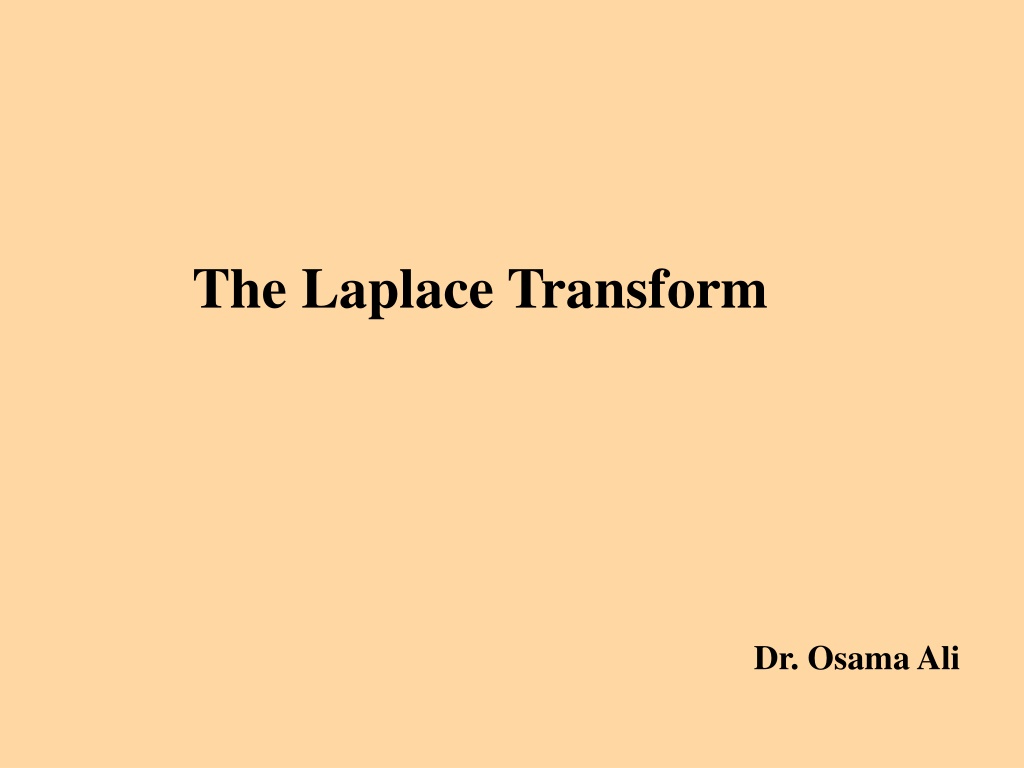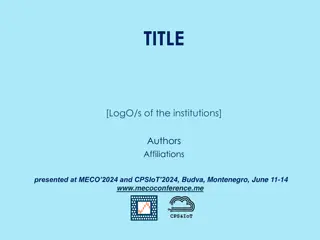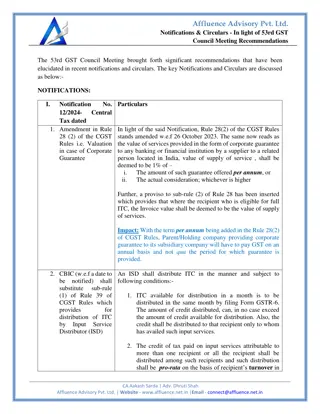
Understanding Laplace Transform and Its Applications
Discover the Laplace Transform and how it simplifies problem-solving by converting mathematical thinking. Explore its applications, including transforming functions, solving differential equations, and navigating the complex plane. Learn about the inverse Laplace Transform and methods for its calculation.
Download Presentation

Please find below an Image/Link to download the presentation.
The content on the website is provided AS IS for your information and personal use only. It may not be sold, licensed, or shared on other websites without obtaining consent from the author. If you encounter any issues during the download, it is possible that the publisher has removed the file from their server.
You are allowed to download the files provided on this website for personal or commercial use, subject to the condition that they are used lawfully. All files are the property of their respective owners.
The content on the website is provided AS IS for your information and personal use only. It may not be sold, licensed, or shared on other websites without obtaining consent from the author.
E N D
Presentation Transcript
The Laplace Transform Dr. Osama Ali
Definition Transforms -- a mathematical conversion from one way of thinking to another to make a problem easier to solve problem in original way of thinking solution in original way of thinking solution in transform way of thinking inverse transform transform 2. Transforms
problem in time domain solution in time domain inverse Laplace transform Laplace transform solution in s domain Other transforms Fourier z-transform wavelets 2. Transforms
Laplace transformation time domain linear time domain solution differential equation Laplace transform inverse Laplace transform Laplace transformed equation algebra Laplace solution Laplace domain or complex frequency domain 4. Laplace transforms
Basic Tool For Continuous Time: Laplace Transform = = st L [ ( )] ( ) ( ) f t F s f t e dt 0 Convert time-domain functions and operations into frequency-domain f(t) F(s) (t R, s C) Linear differential equations (LDE) algebraic expression in Complex plane Graphical solution for key LDE characteristics Discrete systems use the analogous z-transform
The Complex Plane (review) Imaginary axis (j) = + u x jy y y = 1 tan u r x r x Real axis = + 2 2 | | | | u r u x y y = u (complex) conjugate x jy
The Laplace Transform The Laplace Transform of a function, f(t), is defined as; 0 = = st L f t F s f t e dt [ ( )] ( ) ( ) Eq A The Inverse Laplace Transform is defined by + F j 1 Eq B = = tsds 1 L F s f t s e [ ( )] ( ) ( ) 2 j j *notes
The Laplace Transform We generally do not use Eq B to take the inverse Laplace. However, this is the formal way that one would take the inverse. To use Eq B requires a background in the use of complex variables and the theory of residues. Fortunately, we can accomplish the same goal (that of taking the inverse Laplace) by using partial fraction expansion and recognizing transform pairs.
The Laplace Transform Laplace Transform of the unit step. 1 |0 = = st st L u t e dt e [ ( )] 1 s 0 1 = L u t [ ( )] s The Laplace Transform of a unit step is: 1 s
The Laplace Transform The Laplace transform of a unit impulse: Pictorially, the unit impulse appears as follows: (t t0) f(t) t0 0 Mathematically: + t 0 (t t0) = 0 t 0 = t t dt ( ) 1 0 0 t 0 *note
The Laplace Transform The Laplace transform of a unit impulse: An important property of the unit impulse is a sifting or sampling property. The following is an important. t t f t t t t ( ) 2 1 t 0 1 0 2 ) = f t t t dt ( ( ) 0 t t t 0 , 0 1 0 2
The Laplace Transform The Laplace transform of a unit impulse: In particular, if we let f(t) = (t) and take the Laplace [ = = = st s 0 L t t e dt e ( )] ( ) 1 0
The Laplace Transform An important point to remember: f t F s ( ) ( ) The above is a statement that f(t) and F(s) are transform pairs. What this means is that for each f(t) there is a unique F(s) and for each F(s) there is a unique f(t). If we can remember the Pair relationships between approximately 10 of the Laplace transform pairs we can go a long way.
The Laplace Transform Building transform pairs: e 0 0 + = = at at st s a t ( ) L e u t e e dt e dt [ ( )] L( e st ( e + + 1 |0 = = = = L e u t [ ( )] at + + s a s a ) 1 at e u t ( ) A transform pair + s a
The Laplace Transform Building transform pairs: 0 = st L tu t te dt [ ( )] u = t dv = e-stdt 0| 0 0 = udv uv vdu 1 s A transform pair tu t ( ) 2
The Laplace Transform Building transform pairs: + jwt jwt e e ( ) = st [cos( L wt e dt )] 2 0 1 1 1 = + s jw s jw 2 s = + 2 2 s w s A transform pair wt u t cos( ) ( ) + 2 2 s w
The Laplace Transform Time Shift a = st L f t a u t a f t a e [ ( ) ( )] ( ) = , = as = x + Let x t a then dx dt and t x a , As t a x and t So 0 , . , 0 0 + = s x a as sx ( ) f x e dx e f x e dx ( ) ( ) = as L f t a u t a e F s [ ( ) ( )] ( )
The Laplace Transform Frequency Shift 0 = at at st L e f t e f t e dt [ ( )] [ ( )] 0 + = = + s a t ( ) f t e dt F s a ( ) ( ) = + at L e f t F s a [ ( )] ( )
The Laplace Transform Example: Using Frequency Shift Find the L[e-atcos(wt)] In this case, f(t) = cos(wt) so, s = F s ( ) + 2 2 s w + s a + ( ) + = and F s a ( ) + 2 2 s a w ( ) + s a + ( a ) = at L e wt [ cos( )] + 2 2 s w ( ) ( )
The Laplace Transform Time Integration: The property is: 0 0 t = st L f t dt f x dx e dt ( ) ( ) 0 Integrate by parts : t 0 = = Let u f x dx du f t dt ( ) , ( ) and 1 = = st st dv e dt v e , s
The Laplace Transform Time Integration: Making these substitutions and carrying out The integration shows that 1 s = st L f t dt f t e dt ( ) ( ) 0 0 1 s = F s ( )
The Laplace Transform Time Differentiation: If the L[f(t)] = F(s), we want to show: df t ( ) = L sF s f [ ] ( ) ) 0 ( dt Integrate by parts: = = = = u e du se dt and , st st df t ( ) = = = = = = dv dt df t so v f t ( ), ( ) dt *note
The Laplace Transform Time Differentiation: Making the previous substitutions gives, dt df | 0 = st st L f t e f t se ( ) ( ) dt 0 0 = + st f s f t e dt 0 ) 0 ( ( ) So we have shown: df t ( ) = L sF s f ( ) ) 0 ( dt
The Laplace Transform Time Differentiation: We can extend the previous to show; 2 df t ( ) = 2 L s F s sf f ( ) ) 0 ( ) 0 ( ' 2 dt 3 df t ( ) = 3 2 L s F s s f sf f ( ) ) 0 ( ) 0 ( ' ) 0 ( ' ' case 3 dt general n df t ( ) = n n n 1 2 L s F s s f s f ( ) ) 0 ( ) 0 ( ' n dt ) 1 . . . n ( f ) 0 (
The Laplace Transform Transform Pairs: f(t) F(s) ) ( t 1 1 s u t ( ) f t F s ( ) ( ) __________ __________ __________ ______ 1 st e + + s a 1 s t 2 n ! n t + + n 1 s
The Laplace Transform Transform Pairs: f(t) F(s) 1 at te ( ( ) ) 2 + + s a n ! n at t e + + n 1 + + s a ( ) w + + wt sin( ) 2 2 s w s wt cos( ) 2 2 + + s w
The Laplace Transform Transform Pairs: f(t) F(s) w at e wt sin( ) + + 2 2 s a w ( ) + s a + at e wt cos( ) + 2 2 s a w ( ) + s w sin cos + wt sin( ) Yes ! Yes ! + 2 2 s w s w cos sin + wt cos( ) + 2 2 s w
The Laplace Transform Common Transform Properties: f(t) F(s) t s o f t t u t t t e F s ( ) ( ), 0 ( ) 0 0 0 t s o + + f t u t t t e L f t t ( ) ( ), 0 [ ( ) 0 0 at + + e f t F s a ( ) ( ) n d f t ( ) n n n n 1 2 0 1 s F s s f s ) 0 ( ' f s f f ( ) ) 0 ( . . . ) 0 ( n dt dF s ( ) tf t ( ) ds t 1 s ( d f F s ) ( ) 0
The Laplace Transform Using Matlab with Laplace transform: t 4 te Example Use Matlab to find the transform of The following is written in italic to indicate Matlab code syms t,s laplace(t*exp(-4*t),t,s) ans = 1/(s+4)^2
The Laplace Transform Using Matlab with Laplace transform: Example Use Matlab to find the inverse transform of ) 6 ( 2 s s s + + + + + + + + s s = = F s prob ( ) 12 . 19 . ( 3 )( 6 18 ) syms s t ilaplace(s*(s+6)/((s+3)*(s^2+6*s+18))) ans = -exp(-3*t)+2*exp(-3*t)*cos(3*t)
The Laplace Transform Theorem: Initial Value Theorem: If the function f(t) and its first derivative are Laplace transformable and f(t) Has the Laplace transform F(s), and the exists, then sF s lim s ( ) = = = = sF s f t f lim s ( ) lim t ( ) ) 0 ( Initial Value Theorem 0 The utility of this theorem lies in not having to take the inverse of F(s) in order to find out the initial condition in the time domain. This is particularly useful in circuits and systems.
The Laplace Transform Example: Given; Initial ValueTheorem: + + s ( ) 2 = = F s ( ) 25 + + 2 + + s ( ) 1 Find f(0) 2 + + + + s s s s ( ) 2 2 + + 2 = = = = = = f sF s s ) 0 ( lim s ( ) lim s lim 2 2 + + + + + + + + s s ( ) 1 5 2 1 25 s 2 2 2 + + s s s s 2 2 = = = = lim s 1 2 2 2 + + + + s s s s s 2 ( 26 )
The Laplace Transform Theorem: Final Value Theorem: If the function f(t) and its first derivative are Laplace transformable and f(t) has the Laplace transform F(s), and the exists, then sF s lim s ( ) = = = = ( sF s f t f lim ( ) lim ( ) ) Final Value Theorem s 0 t Again, the utility of this theorem lies in not having to take the inverse of F(s) in order to find out the final value of f(t) in the time domain. This is particularly useful in circuits and systems.
The Laplace Transform Example: Final Value Theorem: Given: 2 2 + + s ( ) 2 3 1 = = = = F s note F s te t ( ) ( ) cos 3 t 2 2 2 + + + + s ( ) 2 3 . Find ( f ) 2 2 + + s ( ) 2 3 ( = = = = = = f sF s s ) lim s ( ) lim s 0 2 2 + + + + s ( ) 2 3 0 0






















